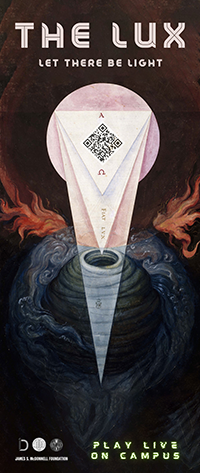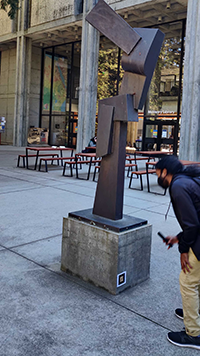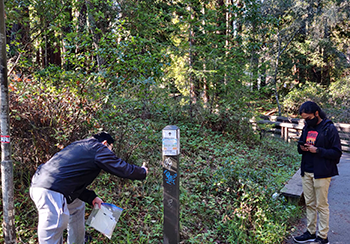Two students approach the Quarry Amphitheater, phones in hand, ready to find and scan a small marker that will provide them with clues to a mystery rooted in UC Santa Cruz’s past. A group, calling themselves Kerr’s Loyalists, had sent them on a mission: scour the campus to look for a secret artifact that can return the University to its original values. A quick message in their Discord channels alerts the rest of their four-person team that they’ve successfully found the nondescript marker, and following congratulations from the team, they're off to decode the next puzzle.
These students were participating in a play-test session of “LUX,” an alternate reality historical fiction game designed by researchers in UCSC’s Game User Interaction and Intelligence (GUII) Lab directed by computational media professor and department chair Magy Seif El-Nasr and the Interaction Dynamics (ID) Lab directed by Assistant Professor of Computational Media Elin Carstensdottir. “LUX” was designed as a non-traditional research project to measure the resilience of its players. This fall, the game will officially launch, recruiting participants from the incoming first-year class, particularly targeting those from historically marginalized communities.
While resilience has been studied for decades by psychology researchers, the team of engineers hopes to leverage technology to create a game that can serve as a better, more innovative approach to this research. The researchers are currently focused on designing the game to be engaging and discovering the best ways to measure the complicated topic of resilience. They have aspirations to further enhance the game with interventions that work to build the resilience of its players and connect them to resources on campus.
“Our vision is to have a game or an application to give you a good estimate of your resilience, and then help you to find your weak points and work on it throughout the game, through practice,” said Reza Habibi, the game’s producer and a Ph.D. student in the GUII lab. “It's totally doable.”
Designing “LUX”
The game’s narrative is based in the history of UCSC’s earliest days, when then-UC President Clark Kerr founded the campus as an educational experiment, without letter grades and as a scruffy, free-thinking response to entrenched conservative thought of the 1950s. Players are enlisted to aid a fictional group called Kerr’s Loyalists, who need their help finding a secret stolen artifact that they say is the key to returning the campus to its original values, which they claim were lost along with the artifact when the campus started implementing letter grades in the 80s.
Teams of three or four students participate in the game over a session that lasts several weeks, communicating with each other and the game moderators on the messaging platform Discord. Along the way, the players must find augmented reality (AR) markers – scannable tokens that bring virtual elements such as games and animations into the physical world – that lead them to solve a series of puzzles and smaller mysteries which require collaboration among the team. In exploring the campus for clues, students can gain familiarity with their new home.
The moderators are characters who guide them through the story and who are named after elements of the natural environment of UCSC, such as “Empire Cave,” “Mima Mound,” and “Oracle Oak.” In reality, these are the games’ designers, most of whom are Computational Media Ph.D. students at the Baskin School of Engineering, getting into character and interacting directly with the players. So far, the researchers have run two play test sessions during the 2021-22 academic year in order to gather more insight on how to best measure resilience and smooth out wrinkles in the game’s narrative and execution before the official launch.
This combination of a fictional narrative played out in the real world – both in physical and virtual spaces – makes “LUX'' an alternate reality game (ARG), a format which the researchers believe has the ability to transform psychology research. They see using an ARG for this type of research as a better way of measuring resilience as it does not remove the participants from their natural, day-to-day environments, unlike more traditional studies performed in a lab setting.
“One of the reasons I find ARGs fascinating is because they blend this aspect of reality and fiction in a strange way,” said Bjarke Larsen, a game designer and Ph.D. student in the ID lab whose research is centered around narrative in ARG. “They use real world elements, websites, and physical locations but also have a fictional element of characters, which people interact with in a very similar way to how they would interact with nonfictional elements.”
This format allows the designers to keep their players engaged through an intriguing narrative that includes interactivity, as the participants’ choices allow them to prod at and modify the story. Increased engagement can keep the participants involved for longer, giving the researchers a better chance to study how resilience changes over time.
“If you're not engaged in the game, you're not going to get any benefit from it,” Seif El-Nasr said. “So that was our first motive: to figure out how to engage the students in a game they care about.”
Measuring resilience

As the players progress through the storyline, the team of researchers collect a wealth of data that goes into their measure of resilience, an important concept that holds many possible definitions within the field of psychology and beyond. While the researchers are not pinned down by any traditional definition of resilience, they generally see the term as representing the ability of a person to bounce back and recover in the face of challenges. They are also interested in a person’s ability to regulate their emotions and find and maintain social connections during challenging times.
The research team sees resilience as especially important in light of the COVID-19 pandemic, extreme weather events, and political and social unrest. Seif El-Nasr says universities have a role in developing the resilience of their students in order to make them better learners and more prepared for the challenges of life ahead of them.
“Resilience is a way of coping through life and its changes,” Seif El-Nasr said. “This, to me, is why resilience is a very important quality, and it can be learned and increased through the right approaches to learning.”
The team particularly hopes to support historically marginalized students, who are more likely to face barriers to success in engineering courses. The researchers note that the group’s approach to studying resilience must be nuanced and flexible to the diverse experiences of their participants, and they must strive to be as unbiased as possible in their research.
“When you want to study any aspect of resilience, you need to be very careful about your populations, your focus groups, their personalities, and their cultures and backgrounds,” Habibi said. “When you review literature and definitions, some people even define resilience as a strong connection to your culture. You can not go and tackle all of this with one game, you need to be very dynamic, and that is why this is a very long and complicated project – there are thousands of factors.”
The researchers are taking a data-driven approach to this project, as outlined in a new paper which was named the best paper at the 2022 International Conference on Human Computer Interaction in Games. Their methods involve evaluating information collected from social mechanics within the game relating to collaboration, compliments, recommendation, and encouragement. The team has created data visualizations from the two play test sessions that have occurred so far, and will collaborate with psychologists to translate this data into measurements of resilience.
Players are instructed to keep daily diaries, and the Discord chat allows the researchers to monitor how the players struggle and cope with the need to solve the game’s challenging puzzles on top of their lives as busy students. Pre- and post-game interviews with players help the researchers learn about the player’s coping strategies, and longer-term follow-ups check in on the wellbeing of the players and the degree to which they’ve maintained relationships made during the game.
Future interventions
While the researchers are currently focusing on measuring the resilience of its players, they envision future iterations could include interventions to build resilience. These interventions would be centered around building skills important for success as first-year students: how to find a community on campus, how to approach that community, and how to maintain those relationships.
The researchers aim to better understand the particular needs of historically marginalized students through an ethnography study they will run next fall. They hope that learning more about these student’s pain points can help them target the overall design toward their needs, especially by taking advantage of and connecting students with University resources such as the Multicultural Engineering Program (MEP).

“From a measuring standpoint, we need to see which factors here are important,” Habibi said. “Why can’t they find the support? Is it unavailable, or they don’t know about it, or they know and they’re shy? Then the intervention comes; they might need a better relationship with their professors, we could introduce them to an existing support system, or tell them how to ask for help in a better way in our game.”
As they gear up for the official game launch this upcoming fall, the researchers note that feedback from their test sessions told them that not only were students genuinely interested in the story and characters of the game, they are making friendships through their teams and gaining deeper benefits from it.
“When we started the game, we mostly focused on production, rather than intervention – but still we got intervention effects after the game,” Habibi said. “That told us that there's a huge potential here.”
Research on this project includes computational media graduate students Reza Habibi, Bjarke Larsen, Jonattan Holmes, Atieh Kashani, Sai Siddartha Maram, Shweta Sisodiya, Zhaoqing Teng, and Jessica Wei, as well as post doctoral fellow Johannes Pfau, under the supervision of Principal Investigator Magy Seif El-Nasr and Co-Principal Investigator Elin Carstensdottir. Research is supported by funding from the James S. McDonnell Foundation.



